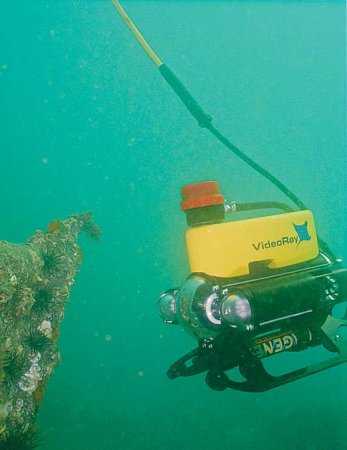Deep-sea explorer Robert Ballard led the team that discovered the wreck of the Titanic in the North Atlantic in 1985. Since that time, more than 100 scientists and tourists have visited the two-mile-deep site in submersibles. Now Ballard has a high-tech plan to radically expand the number of people who can visit the beloved wreck: Equip the Titanic for real-time virtual visitation with a system of video-equipped remotely operated vehicles (ROVs) permanently installed on the ocean floor [see Popular Science‘s rendition of the system in our July issue]. We reached Ballard at home in Connecticut to ask him about what motivates his ambitious plan.
Why do people remain so fascinated with the Titanic?
I think it’s because it offers something to everyone. For men, it was the largest moving object ever created at that time. For women, it represents the Edwardian era of elegance. To children, it is one of the biggest mistakes adults ever made.
Do you think that a virtual presence there is needed to maintain that interest?
The interest would be perpetual anyway, but with technology, large numbers of people will be able to visit a site they would not otherwise be able to see for themselves.
Your plan is to wire the Titanic for ROVs that would allow virtual visitation by the masses. What’s the most likely scenario for making that happen?
The plan for expanding “electronic travel” in the ocean is to start with other easier sites first and then move to the Titanic after a market has been established. Then, the high cost of installing the system can be overcome through a broad customer base. We’re already establishing that customer base by wiring [national marine sanctuaries in] Monterey Bay, Santa Barbara, the Florida Keys and Thunder Bay, as well as through other projects such as a live broadcast in June from an expedition to the Lost City hydrothermal vents on the Mid-Atlantic Ridge www.ife.org. The national marine sanctuaries and NOAA [the National Oceanic and Atmospheric Administration] are funding the current work, and we have an expanding network of museums, aquariums and science centers involved.
What do you hope electronic travel will eventually become?
We see Internet2 as our delivery system. Right now it has a bandwidth of 10 gigabytes that can move high-definition images. That bandwidth will inevitably increase and be brought into people’s homes. Imagine a family-size, probably spherical entertainment room the size of a bedroom, The family sits in the center, and they can rent a vehicle or a camera system at some location around the world and travel there electronically at the speed of light. Right now people have 52 vacations called weekends, but they can’t get anywhere, so they watch football games where cameras take you into the huddle and everywhere else. Imagine renting those kinds of cameras for an hour on Titanic and being able to control them from that entertainment room.
How important do you think it is to find ways to give the public access to ocean sites such as historic wrecks and the national marine sanctuaries?
How important was it to create Yellowstone Park or Yosemite? It’s the same basic idea. What we’re talking about doing is building underwater ring roads analogous to the ones you find at the national parks that take you to sites like Old Faithful and the other points of interest.
How confident are you that electronic travel is actually going to happen at the Titanic?
I have very high confidence. It’s not “if” but “when.”
What’s your vision for long-term preservation of the ship?
What we want to do is go down and clean it. They’ve been building offshore oil platforms so big that once they’re launched they can never be put in dry dock; they have developed the technology to clean those structures underwater and paint them underwater, and that’s the kind of thing I’d like to see at Titanic. If you tell an older person that, they say you’re nuts, but if you tell a kid, they ask, “What color?”
You’re serious about trying this?
We already have a robot that could do the cleaning work, and we’re looking at how to apply the paint. I have a grad student researching it right now. I think it will be only natural to invest in that kind of preservation once the site becomes an electronic travel destination. Imagine if Titanic was a house, like Monticello. Do you let Monticello just rot? Of course not.
In your 1987 book The Discovery of the Titanic, you described a dive to the wreck when you “mused for a moment on what it would be like taking a steel brush to the hull and cleaning the ship to its former smoothness.” Your conclusion then was: “But I had made a promise to myself to leave the ship undisturbed.” What changed your mind?
What keeps going through my mind is: How can I preserve the Titanic without changing its present appearance? I ask children the question, What color should I paint the Titanic, its original black hull or a color that looks like the way it is today, just preserved? The vast majority wants the latter so that it doesn’t look out of place. Also, I didn’t realize at the time [in the 1980s] that the rusticles [the brown icicle-like growths that give the ship its dripping-metal appearance] were the action of organisms that are attacking the ship.
So when are you planning to go back to Titanic?
As soon as they’ll let me get started with the cleaning and painting.






